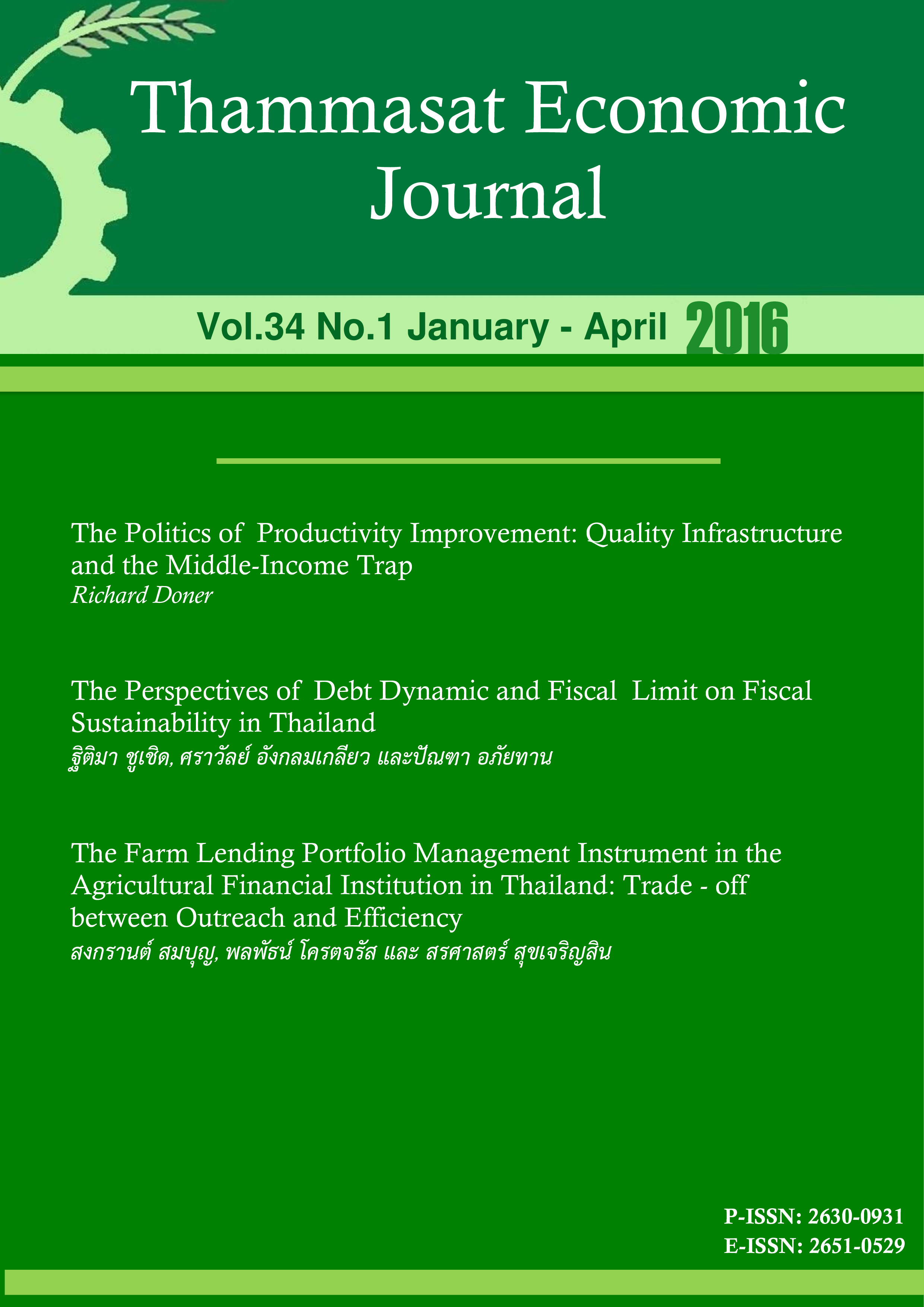The Farm Lending Portfolio Management Instrument in the Agricultural Financial Institution in Thailand: Trade - off between Outreach and Efficiency
Keywords:
farm lending portfolio, small farmer, risk adjusted return on capital, expected lossAbstract
The main objective of this study is to develop the farm lending portfolio management instrument in order to analyze for the optimum level of the trade-off between outreach to the small farmer and efficiency of the farm lending portfolio in the Bank for Agriculture and Agricultural Cooperatives (BAAC.), an important agricultural financial institution in Thailand. The logit model is first developed to identify the probability of default from the risk factors. The results from the logit model are subsequently employed to formulate the probability of default equation, expected loss model, economic capital model, risk and capital charge adjusted of the loan pricing model and internal rating model including the average RAROC of the portfolio in each of rating. The expected profit before expected loss equation and the average of the risk adjusted return on capital equation are developed to analyze the optimum level. The equations can be identified the maximum level of the expected profit before expected loss of the portfolio and optimum level of the trade-off between outreach to the small farmer and efficiency of the farm lending portfolio. The different from the maximum level to the optimum level can be calculated the size of the trade-off. The BAAC can be employed to the optimum level of the trade-off managing the farm lending portfolio and determine the optimum of the interest rate structure in the portfolio.
References
จิรพร สุเมธีประสิทธิ์. (2554, กรกฏาคม). RAROC เครื่องมือวัดผลดำเนินงานตามฐานความเสี่ยง. ศูนย์ข้อมูลความรู้เกี่ยวกับการบริหารความเสี่ยง.205. สืบค้นเมื่อ 19 พฤศจิกายน 2557. จาก https://Chirapon.wordpress.com
วันทนี สุรไพฑูรย์กร และ ชูชัย ศรีศันสนีย. (2548). Basel II & การบริหารความเสี่ยง.กรุงเทพฯ:ไฮ-ควอน มัลติมิเดีย จำกัด.
สงกรานต์ สมบุญ. (2558). ระบบบริหารความเสี่ยงกลุ่มสินทรัพย์ลงทุนประเภทสินเชื่อการเกษตร สำหรับตลาดการเงินในชนบทไทย. วารสารเศรษฐศาสตร์ธรรมศาสตร์. 33 (1): 76-122.
Bandyopadhyay, A. (2007). Credit risk models for managing bank’s agricultural loan portfolio. ICFAI Journal of Financial Risk Management. 5(4): 86-102.
Bandyopadhyay, A., & Saha, A. (2007).RAROC & EVA: The New Drivers of Business Growth in Indian Banks (No. 8920). University Library of Munich, Germany.
Bank of Thailand. (2013). Supervisory Guideline on Capital Fund under Pillar I of Basel II capital Accord, dated 15 January 2013, Accessed February 2014, Available at https://www.bot.or.th/Thai/FinancialInstitutions/Highlights/baselIII/Documents/Basel_II_III_AM. pdf
Basel Committee on Banking Supervision: BCBS. (2005), Studies on the Validation of Internal Rating System, Working Paper No.14.Bank for International Settlements, May.
Bessis, J. (2010). Risk Management in Banking, 3rd ed. West Sussex: John Wiley & Son Ltd. Chlopek, P.S. (2013).RAROC as a credit risk approach. Nauki O Finansach.3(16): 64-76.
Dinh,T.H.T. & Kleimeier, S. (2007). A credit scoring model for Vietnam’s retail banking market, International Review of Financial Analysis.16(5):471-495.
Geyfman, V. (2005). Risk-adjusted performance measures at bank holding companies with section 20 subsidiaries, working paperno.05-26. Research department, Federal Reserve Bank of Philadelphia.
Hermes, N.& Lensink, R. (2011). Microfinance: It’s impact, outreach, and sustainability. World Development. 39(6): 875-881.
Hermes, N., Lensink, R.& Meesters, A. (2011). Outreach and efficiency of microfinance institutions. World Development. 39(6): 938-948.
Kritayakirana, K., Srithongdee, C. &Kunaphinya, S. (2011).Credit Risk Management with Basel II, RAROC (Risk adjusted Return on Capital), and Risk-Based Pricing-Workshop & Case Study. Bangkok, Thailand: The Thai Institute of Banking and Finance Association.
Lee,T.H.,& Jung, S. (2000). Forecasting creditworthiness: logistic vs. artificial neural net. The Journal of Business Forecasting Methods and Systems. 18 (4): 28-30.
Limsombunchai, V.(2007).An Analysis of Credit Scoring Model for Rural Financial Market in Thailand.ARE Working Paper No.2550/1.Department of Agricultural and Resource Economics, Faculty of Economics, Kasetsart University, Bangkok.
Ohlson,J.A. (1980).Financial Ratios and the Probabilistic Prediction of Bankruptcy.The Journal of Accounting Research.18: 109-131.
Overbeck, L.(2004).RAROC framework, integration and stress testing, Risk Management Workshop Colombia: from Theory to Implementation. Cartagena, Columbia.
Robinson, M. S. (2001). The microfinance revolution: sustainable finance for the poor. World Bank Publications.
Tirapat,S. & Kiatsupaibul,S. (2008).Introduction to Credit Scoring. [Lecture note]. Special Lecture at the Bank for Agriculture and Agricultural Cooperatives (Head office), February 13, 2008.
Turvey, C.G., & Brown, R.(1990).Credit scoring for a federal lending institution: the case of Canada’s farm credit corporation.Agricultural Finance Review. 50:47-57.
Turvey, C.G., &Weersink, A. (1997).Credit risk and the demand for Agricultural loans.Canadian Journal of Agricultural Economics.4:201-217.










